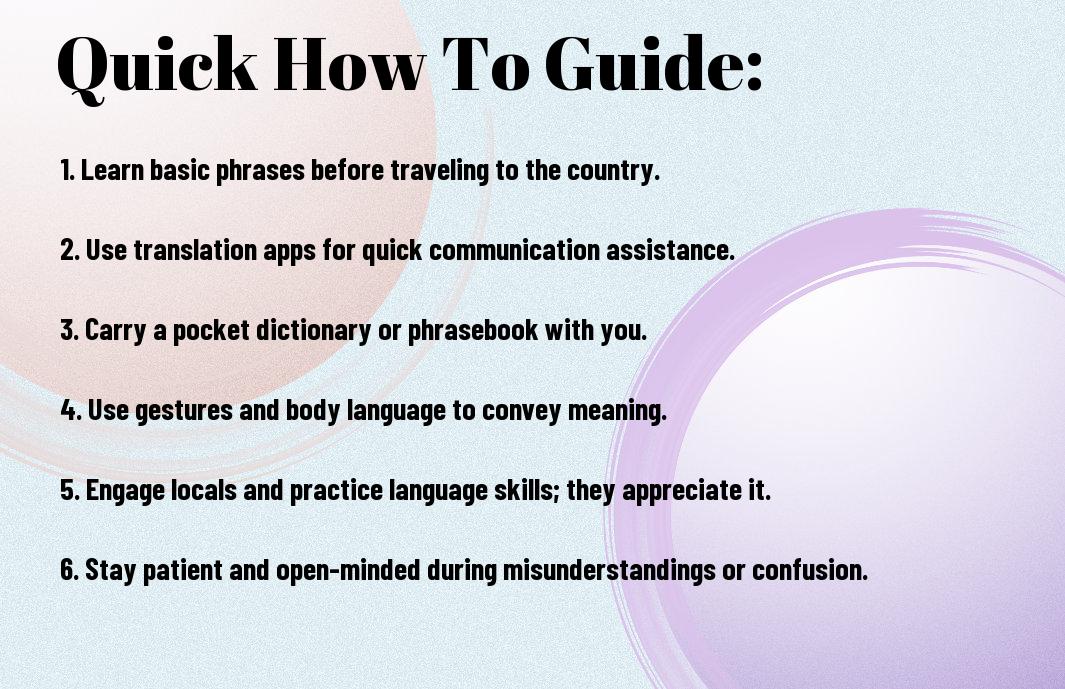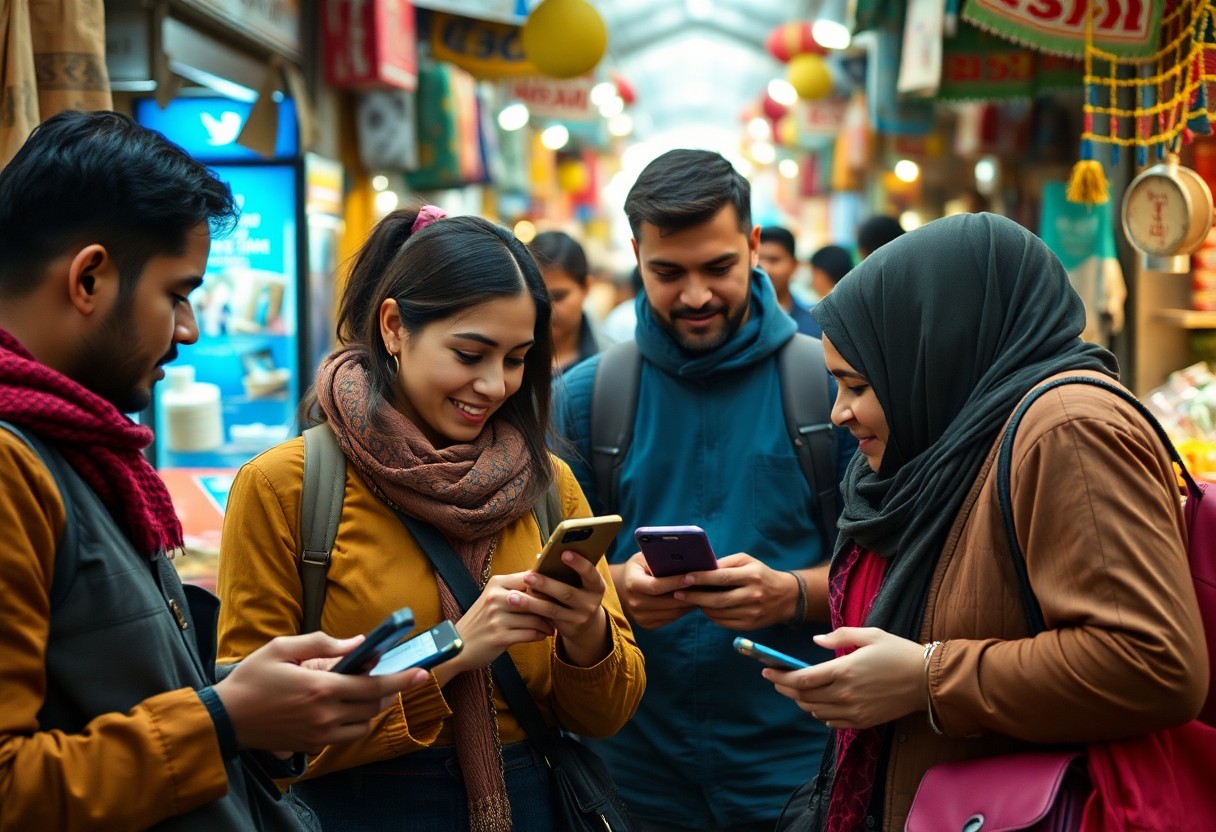There’s no denying that traveling to a foreign country can be both exciting and challenging, especially when you encounter language barriers. Effective communication is key to enriching your travel experience and fostering connections with locals. In this guide, you’ll discover practical strategies and tools to help you navigate these obstacles with confidence, whether you’re ordering food, asking for directions, or engaging in meaningful conversations. With these tips at your disposal, you can enhance your travels and make the most of your adventures abroad.
Key Takeaways:
- Learn Basic Phrases: Familiarize yourself with important expressions in the local language to enhance communication.
- Use Translation Apps: Leverage technology by downloading reliable translation apps to assist in real-time conversations.
- Non-verbal Communication: Utilize gestures, body language, and facial expressions to convey meaning when words fail.
- Be Patient and Polite: Approach language barriers with a calm attitude, showing respect and willingness to communicate.
- Visual Aids: Employ pictures, maps, or written instructions to bridge understanding when specificity is needed.

Understanding Language Barriers
The concept of language barriers revolves around the challenges faced when individuals who speak different languages attempt to communicate. These barriers can lead to misunderstandings and misinterpretations, significantly impacting your travel experience. It’s important to recognize that language is not just about speaking; it encompasses cultural nuances and expressions that may not translate directly. Embracing these complexities will help you navigate conversations more effectively while abroad.
Common Factors Contributing to Language Barriers
With your interactions in a foreign country, various factors can contribute to language barriers, including:
- Differences in dialects and regional accents
- Varying levels of proficiency in a common language
- Cultural references and idioms that do not translate
Perceiving these elements can enhance your understanding of the local language landscape.
The Impact of Language Barriers on Communication
Contributing to misunderstandings, language barriers can significantly hinder effective communication and lead to frustrating experiences. When nuanced expressions and contextual meanings are lost, messages may become distorted or entirely misinterpreted, resulting in confusion. In unfamiliar environments, this can adversely affect your ability to gather important information, seek assistance, or build meaningful connections with locals.
This can also create feelings of isolation during your travels as you struggle to express your needs or understand others. Language barriers may limit your ability to engage fully in the culture or enjoy local experiences, hindering your overall travel enjoyment. By acknowledging these potential pitfalls, you can take proactive steps to mitigate their impact and enjoy a smoother interaction with the people you meet.
How to Prepare for Travel
If you want to navigate language barriers smoothly, preparation is necessary. Start by researching the local language and customs of the country you plan to visit. Familiarize yourself with common phrases, practice pronunciation, and even consider enrolling in a basic language course. The more prepared you are, the more confident you will feel while interacting with locals during your travels.
Learn Basic Local Phrases
Phrases can be a game changer when traveling to a foreign country. Focus on necessary expressions such as greetings, directions, and polite requests. You’ll find that even a few well-practiced words can bridge the gap between you and the people you meet, fostering goodwill and making your experience more enjoyable. Additionally, locals often appreciate your effort, which can lead to more meaningful interactions.
Utilize Technology and Translation Apps
For seamless communication, consider harnessing the power of translation apps. These tools can help you quickly convert written text or spoken phrases, making it easier to understand menus, signs, or locals’ conversations. You can communicate more effectively and gain confidence in navigating your surroundings, allowing you to focus on the adventure rather than on your language limitations.
Apps like Google Translate, Duolingo, and iTranslate offer features that go beyond simple translations. Many provide offline capabilities, document scanning, and even voice recognition to help you communicate in real-time. With these apps at your fingertips, you can effortlessly learn new phrases on the go or decipher written text instantly, granting you the freedom to fully immerse yourself in the local culture without feeling lost in translation.
Tips for Effective Communication
Your communication skills can significantly enhance your travel experience. Here are a few tips to help you connect with locals:
- Learn key phrases in the local language.
- Utilize translation apps for complex conversations.
- Be patient and open-minded.
- Use gestures and visual aids to convey your message.
This can be further explored in 4 Ways to Overcome Language Barriers When Traveling.
Non-Verbal Communication Techniques
Communication extends beyond words; utilizing non-verbal techniques can bridge gaps in understanding. Facial expressions, gestures, and body language can convey your intent even when words fail. Emphasizing these cues, such as using thumbs-up for approval or a frown for discontent, can greatly enhance interactions. Carrying a visual dictionary or drawing pictures can further assist in expressing your needs.
Engaging Local Guides and Interpreters
Communication with locals can be enriched through hiring guides or interpreters. They not only serve as language facilitators but can also provide invaluable insights into cultural nuances and traditions. Engaging a local guide can help you navigate conversations more effortlessly, ensuring a more authentic experience during your travels.
Effective guides and interpreters often have deep knowledge of the regional dialect and customs. By utilizing their expertise, you can foster meaningful connections with residents and gain a better understanding of their way of life. This can turn an average trip into a memorable cultural immersion, allowing you to appreciate the destination from a unique perspective.
Navigating Social Situations
Once again, mastering language nuances can significantly enhance your social experiences abroad. Whether you’re attending a local event or mingling at a party, being mindful of cultural differences and local customs will help you feel more at ease. Approach conversations with a friendly demeanor, even if you struggle with the language, as your willingness to engage will foster better connections with those around you.
Tips for Dining and Shopping
Dining in a foreign country can be a delightful experience. When ordering food or shopping, consider the following tips:
- Learn basic menu vocabulary to make ordering easier.
- Use visuals, like pictures or pointing, to help convey your needs.
- Practice polite phrases such as “please” and “thank you”.
Recognizing your surroundings and adapting to local etiquette will enhance your interactions.
Engaging with Locals Respectfully
With respectful engagement, you can foster genuine connections with locals during your travels. Always approach situations with an open mind and a willingness to learn about their customs and values. Be aware of body language and non-verbal cues, as these play a significant role in communication. This attitude will help you navigate conversations with grace while creating memorable experiences.
Shopping overseas can be much more than just a transaction. You’ll often encounter unique products and the opportunity to converse with shopkeepers. Showing appreciation for their craft by asking questions or complimenting their work can lead to insightful exchanges. Additionally, using gestures or translating apps can bridge any language gaps you may have faced, ensuring a more enjoyable shopping experience.
Overcoming Misunderstandings
After encountering a language barrier, misunderstandings can often arise, leading to frustration and confusion. It’s important to stay calm and approach these situations with patience. By being aware of potential misinterpretations, you can actively work to resolve issues and foster clearer communication. Don’t hesitate to ask for clarification or repetition, as this can help bridge the gap between different languages and cultural nuances.
Strategies for Clarifying Conversations
Overcoming misunderstandings starts with employing effective strategies. Always ask open-ended questions that require more than a yes or no answer, encouraging deeper dialogue. Paraphrasing what you’ve heard can also help verify understanding, as it allows the other person to confirm or correct your interpretation. Engaging in active listening and maintaining a positive attitude will further enhance communication and ease tensions.
Utilizing Context and Visual Aids
For effective communication, using context and visual aids can significantly enhance your understanding. When words fail, gestures, body language, and relatable visuals can convey meaning and context, helping you make sense of conversations.
Visual cues, such as pictures, maps, or diagrams, can greatly complement verbal communication. Pointing to items in your surroundings or using your phone to show images can clear up confusion easily. Additionally, cultural context—like local foods, clothing, or landmarks—can provide valuable clues to meanings behind words. By combining these strategies, you enable yourself to navigate through the challenges of language barriers with better performance and effectiveness.

Building Cultural Awareness
Many travelers underestimate the importance of cultural awareness when navigating language barriers. Understanding the customs, traditions, and social norms of the country you are visiting can enhance your interactions and foster mutual respect. By taking the time to learn about the local culture, you can bridge the gap created by language differences, making your experiences more enriching and enjoyable.
Understanding Cultural Nuances and Etiquette
Cultural nuances can significantly impact communication, so it’s crucial to grasp the etiquette of the region you are exploring. Simple gestures, such as greetings or body language, may vary from one culture to another. By observing and adopting local customs, you will convey respect and openness, making your efforts to communicate more effective.
Embracing Diversity in Communication
For effective communication, embracing diversity means acknowledging the various ways people express themselves. Different cultures often have distinct norms for verbal and non-verbal communication, and being aware of these differences can lead to more meaningful exchanges.
Etiquette plays a significant role in embracing diversity. Adapting your communication style to the preferences of others, whether through tone, body language, or listening skills, will help you connect better. Practice patience, as you may encounter different communication rhythms; this flexibility will allow you to enjoy diverse perspectives, fostering a richer interaction during your travels.
Summing up
Ultimately, navigating language barriers in foreign countries requires a combination of preparation, patience, and resourcefulness. Equip yourself with basic phrases and cultural knowledge to enhance your interactions. Utilize translation apps and non-verbal communication to bridge any gaps. Don’t hesitate to engage locals, as they often appreciate your efforts and may offer valuable assistance. By remaining open and adaptable, you can turn potential misunderstandings into meaningful connections, enriching your travel experience and deepening your understanding of different cultures.
FAQ
Q: What are some effective strategies for communicating in a foreign country where your language skills are limited?
A: When navigating language barriers, consider using visual aids such as pictures or maps to convey your message. Gestures can also be helpful, so use body language to supplement your communication. Another effective strategy is to learn a few key phrases in the local language, which can demonstrate effort and help in gaining respect from locals. Additionally, utilizing translation apps on your mobile device can provide real-time assistance when you’re struggling to communicate.
Q: How can I ensure that I understand local customs and cultural nuances when language is a barrier?
A: To better understand local customs, research the culture of your destination prior to your trip. Watching videos or reading articles about cultural etiquette can provide valuable insight. Engaging with locals, even with limited language skills, can also enhance your understanding of their customs. Consider joining guided tours where local guides can explain cultural practices in English, thereby bridging the language gap while enriching your travel experience.
Q: What tools or resources can assist me in overcoming language barriers while traveling?
A: There are several tools and resources to help you overcome language barriers. Language translation apps, such as Google Translate, can be downloaded to your smartphone for immediate translation assistance. Phrasebooks or language dictionaries can be handy for offline use. Additionally, consider enrolling in language classes or using language learning platforms beforehand to familiarize yourself with the basics. Lastly, networking with fellow travelers through forums or social media can offer tips and support to help you navigate your journey.
